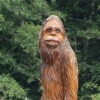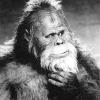Like you I question existence throughout the country but that is based on what I know about active areas in my area of SW WA and Western Oregon. From my experience, and you have to trust me on that, In this area, BF is only found to hang out in areas of heavy cover and running water. They may transit other areas with some sort of migration but the recipe for them to establish in one area and leave sign requires a certain amount of heavy cover and running water. Get away from that and I have never seen any sign of one. Thinner cover may reduce or eliminate day activity and increase the chance of observation by humans. Certainly running water gets more rare East of the Cascades. Both of those may be a factor in your area. Evidence of the effects of cover density is what happened in my research area when the state started to clear cut it. Active areas went inactive when there was not continuous cover allowing movement through the area. Patches of cover do not work long for them when they can simply move away and not take the chance of being seen hunting or moving around in the open. Clear cut, at least the way the state is doing it, leaves patches of cover with no way to move between them. There is little logging in National Forests so it is easy for BF to avoid logged areas there
You mention bears. From what I have seen bears are not as dependent on cover as I have found footprints completely in the open. While bears avoid humans when they can, a sentient creature like BF with what seems to be a prime directive to avoid humans, seems less likely to be seen than a bear who only moves away with direct human contact. Much of grizzly country is fairly open or thinly forested. Get very much East of the Cascades, where forests get more thinly treed, areas like that would not be preferred by BF if they have a choice. They may be there in areas with denser trees. Admittedly I do not have much time in Eastern Washington or Oregon. But looking at the density of sighting reports, that seems to favor the denser forests West of the Cascades in both Oregon and Washington. Of course sightings require people who are much less in numbers East of the Cascades.
One of my bear encounters was a close face to snout encounter on a human trail. Bears follow human trails. I have never found a BF footprint where it was following a human trail. But I have found several paralleling human trails or where the BF stepped across a trail trying to avoid leaving a footprint on a muddy trail. Some one expecting to find a BF print near a human trail should be looking at the trail margins or game trails that parallel them. The only place I have seen a BF footprint completely in the open, away from cover, was on the Eastern flank of Mt St Helens near the lahar where the trees had been cleared out by the 1980 blast. They seem to move between treed areas remaining after the blast. And that is likely at night, when the tourists have headed for their hotels.
While the numbers of BF West of the Cascades in Oregon and Washington may be the highest in the country, they are still very rare. Otherwise they would be seen more often and leave more sign. If their species is like any other, encroachment by humans into their habitat has to be reducing their numbers even more. Like every other bipedal humanoid that has co-existed with humans, they are likely to go extinct at some point. We seem to hurry that along with every species we have contact with.
Thanks. See the doctor again tomorrow and hope to get a handle on what this is. Up to this point he doesn't have a clue.


